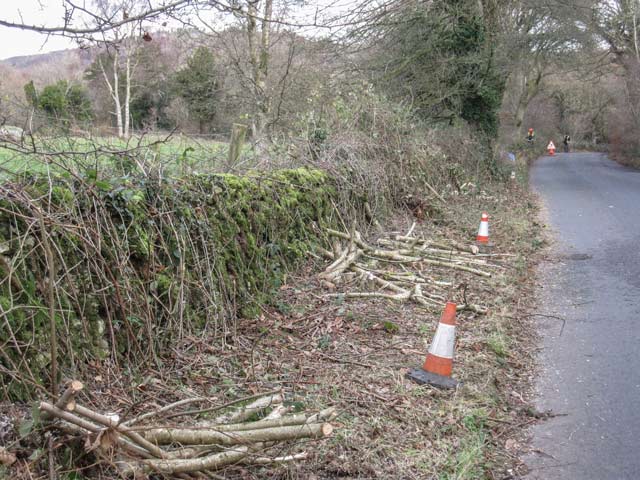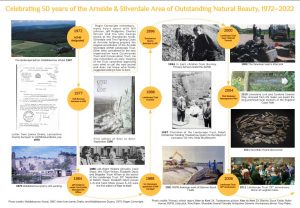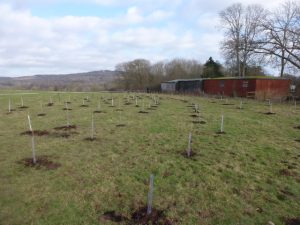
What is happening?
Anyone visiting or driving past our reserve at Coldwell Parrock can hardly have failed to notice that the Landscape Trust is currently undertaking a considerable amount of work on the trees adjacent to our boundary wall and along the side of the public highway.
This work is part of a long term conservation management plan and Countryside Stewardship agreement with the Forestry Commission and Natural England, to restore and maintain the limestone grassland and semi-natural woodland pasture of our reserve.

Roadside coppicing is currently in progress to maintain the boundary walls and to prevent obstruction of traffic. This will be followed by a small amount of tree surgery to shorten overhanging branches and reduce the crowns on six trees as well as the felling of three further small and poor-quality trees. The affected trees have been marked with red paint: an S indicates those identified for surgery; a red dot, those ear-marked for felling. Full details of the work scheduled to be undertaken appear below.
This type of work by its very nature may appear destructive. It is, however, essential to good management of the reserve and is needed now in order to reduce the risk of future damage to our boundary walls and to reduce potential hazards for road users. In addition, the work will maintain the amenity of the roadside and will eventually benefit wild life interest, particularly wild flowers and butterflies, for which the area is famous.
If you visit Coldwell Parrock whilst these works are in progress, please be aware that it may be necessary for some areas of the reserve to be closed for access, particularly when felling operations are in being undertaken. Please observe any footpath or access diversions that are indicated, and respect any cordons that may be put into place. Additionally, there may be times when traffic control measures need to be put into place on the roadway bordering the reserve. These measures are for your safety, as well as for that of our contractors and volunteers. The Trust apologises for any inconvenience that these essential works may cause you.

The planned work in detail
Seven trees (or tree groups) have been identified and marked as requiring work at this time:
- 1. Oak (approx. 80yrs old)
- Surgery: crown reduction to shorten branches overhanging road (5-6 branches)
- 2a. Two larch (approx. 70 years old)
- Surgery
- 1 x crown reduction to shorten branches overhanging road (4-5 branches)
- 1 x shorten overhanging branch to wall line
- 2b. Sycamore/Hazel Coppice
- Cut back
- 3. Sycamore (40-50yrs old)
- Fell: leaning over road
- 4. Larch (40-50yrs old)
- Fell: poor specimen could fall on road, suppressed by oak
- 5. Oak (approx. 150yrs old)
- Surgery: shorten overhanging branch by about 3m
- 6. Ash (30-40yrs old)
- Fell: tall, spindly half-dead tree, hanging over road
- 7. Oak (50-60yrs old)
- Fell: leaning over road and root plate lifting
Additionally, there has been a substantial amount of natural colonisation of trees and shrubs, mainly hawthorn, hazel, holly, ash and sycamore which now forms an irregular and overgrown hedge (up to 9m high) on both sides of – but mostly outside – the roadside boundary walls. In the interests of road-side amenity (as well as safety of road users) this needs cutting back on North-east and South-east boundaries, leaving small specimens of attractive/rare species such as guelder rose and spindle. The Trust regards it as important that cut stumps and regrowth are not treated with chemical/herbicide and that the inevitable coppice regrowth is accepted, even though coppicing will need to be repeated, ideally in another 5 – 8 years.
This work will be undertaken either by our own teams of volunteers, or specialist professional contractors, as appropriate to the nature of the work.





